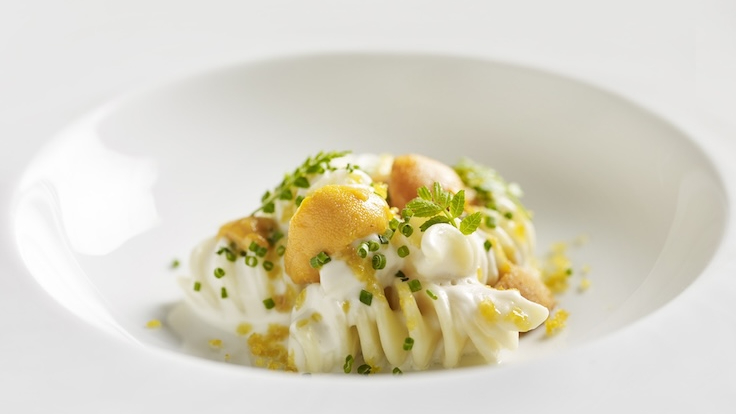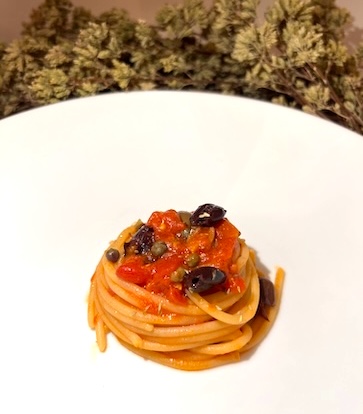The Italian restaurant scene in Singapore has undergone a bit of a renaissance in recent months with the arrival of buzzy overseas brands from the old country (and beyond), as well as a surge in local upstarts popping up around the Lion City.
Locanda, a cosy, decidedly laid-back sister concept to MICHELIN-starred Buona Terra, is one such establishment riding into town as part of this new wave. The trattoria lays bare its sensibilities in its Italian name, which translates simply to mean “inn” — as in, a place where weary travellers can rest and find succour by way of hearty Italian comfort food mixed in with genuine hospitality.
Buona Terra’s Italian resident chef Denis Lucchi, the brains behind the menu, delivers on that promise in a fashion most true to his heart and heritage — with house-baked breads, refreshing salads, large-format convivial meat platters, and most of all, heaps and heaps of handmade pasta.

The Lombardy-born chef now uses pasta in all its various shapes and forms — tubes, swirls, ribbons, rolls, twists, and strands — to craft a bridge between his Italian heritage and diners in Singapore, whether in an elevated form at the refurbished colonial house Buona Terra resides in, or in a more casual format at their newer trattoria.
“Pasta is more than just a meal for an Italian; it's a cultural touchstone, a tradition, and a part of our identity. For me, as an Italian living in Singapore, pasta serves as a comforting reminder of my roots and a connection to home along with countless memories of sharing meals with loved ones.”

The Italian Art of Pasta
Whether it was the Italians who first came up with the idea of turning flour and water into noodles they call pasta — or the Chinese with mien (麵) — remains a hot topic of debate among food historians.
On Lucchi’s part, he maintains that both have their own unique merits. Says the chef, “Italian pasta, typically made with durum wheat flour, undergoes a unique drying process that gives it a rough surface. This, combined with the al dente cooking method, creates a distinct texture and mouthfeel that is difficult to replicate with Asian noodles, which are generally softer and more slippery.”
Al dente is an Italian term used to describe pasta that’s cooked just right. It literally translates as “to the tooth”, meaning that the noodle bites back with just enough resistance to give it a pleasant chew, without feeling too hard or chalky.

On the other hand, the similarities between Chinese noodles and pasta can’t be ignored, as certain Chinese cultures, too, have the term “QQ” for bouncy noodles (so given for Q’s resemblance to the local word for "chewy" in its origin point of Taiwan).
The chef embraces these parallels, saying, “while there are some similarities between certain fresh pasta and Asian noodles, such as Mee Pok and Mee Kia resembling tagliatelle and tagliolini, and ravioli being akin to Asian dumplings, the fundamental differences in ingredients and preparation make the Italian pasta experience truly unique. However, I believe that experimenting with Asian noodles and Italian sauces could be very interesting.”

Getting Hands-on
For any aspiring home chefs looking to kickstart their handmade pasta journey, Lucchi recommends his version of the golden ratio: 100 grams of "00" flour — also known as double zero flour for its ultra-fine grind; you can find this in most specialty grocery stores — to one whole egg.
“From there, you can customise your recipe by incorporating durum flour for a firmer texture or using only egg yolks for a richer flavour. While there are many variations, the 1:1 ratio of flour to egg is a reliable foundation,” he adds.
However, the chef also stresses getting good at making your own fresh pasta is a process that cannot be rushed.
“Perfecting a pasta dough recipe requires countless tries and practice. Each attempt teaches you about the balance of ingredients and the specific properties of the ingredients you're using. It's all a matter of practice and intuition.”
That same practice and intuition applies for boiling pasta, so that it comes out perfectly al dente on the plate, rather than overcooked after the final toss in the sauce. As a rule of thumb, the chef recommends always undercooking your noodles before finishing it in the pan — exactly how much though, you’ll have to find out for yourself.

Lucchi personally enjoys handmade pasta with just a smattering of butter and Parmesan cheese. When he can’t get his hands on the fresh stuff, he prefers having it aglio e olio (tossed with olive oil, garlic and red pepper flakes) or cooked alla peperoncino (lots of chillies).
When it comes to the Buona Terra dining room, however, one recipe stands out above all pastas Lucchi has created: Ravioli stuffed with ricotta and nettles, served with brown butter and sage.
“This dish holds a special place in my heart as it was one of the first stuffed pastas I helped my grandmother prepare. It was also the first time I realised how a seemingly unappealing ingredient like nettles could be transformed into such a delicious dish. Even though I haven't made it in a long time, it remains one of my proudest achievements in cooking pasta,” shares the chef.
Now, nettles would probably be easier to find in his hometown of Brescia, Lombardy, than your local supermarket, so try out Lucchi’s suggestion of a more accessible, home cooking-friendly pasta dish instead.

Denis Lucchi's Pasta alla Puttanesca
Ingredients:
- 400 grams dry pasta like spaghetti
- 3 garlic cloves
- 1 can (400 grams) whole peeled tomatoes or crushed tomatoes
- 4-5 anchovy fillets
- 80 grams pitted black olives, roughly chopped
- 30 grams capers
- Fresh parsley
- Olive oil
- Salt and pepper
- Chilli flakes (optional)
Preparation:
1. Cook the pasta in salted boiling water until al dente.
2. While the pasta is cooking, heat olive oil in a large pan over medium heat. Add the garlic and chilli flakes and cook until the garlic is golden brown.
3. Add the anchovies and stir until melted. Add the crushed tomatoes, olives, and capers, and simmer for 10 minutes or until the pasta is cooked.
4. Drain the pasta and add it to the sauce. Toss the pasta over the heat, adding a bit of pasta water if necessary to create a creamy sauce.
5. Remove from heat and garnish with fresh parsley and crushed pepper.
6. Serve immediately.

A World of Pasta-bilities
You might’ve noticed that Lucchi doesn’t turn up his nose to store-bought dry pasta. That’s because he believes, like with Chinese noodles, that each boasts their own appeal.
“Fresh pasta tends to absorb flavours better and has a more tender texture. However, boxed pasta, especially dry pasta made with durum wheat flour, offers a firmer texture and holds the al dente consistency longer,” shares Lucchi.
Instead, what home chefs should focus on, he says, is the quality of their store-bought pasta. To start with, make sure that the pasta is made with 100 percent durum wheat flour. Avoid glossy or overly yellow noodles in favour of opaque, light-coloured pasta with a rough surface. “These characteristics signify the use of premium ingredients, bronze cut, and slow drying, which are essential for producing high-quality pasta,” he avers.
As with everything, the Buona Terra chef advocates for prioritising quality over sweating the tinier details. “Both fresh and boxed pasta can be exceptional when they are high-quality and prepared correctly,” he says.
Image of Puttanesca courtesy of Denis Lucchi.




















